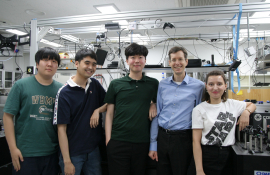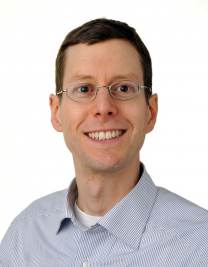- * 프린트는 Chrome에 최적화 되어있습니다. print

In the CRASY lab, we develop and apply correlated spectroscopic techniques for the analysis of heterogeneous (impure) samples.
Most molecular samples are heterogeneous in terms of atomic and isotopic composition, or in terms of isomeric structure. The spectroscopic characterization of heterogeneous samples is difficult because signals originating from different sample components are not easily separated. Would it not be nice if we could mark each sample component before a performing a measurement? We might then sort the spectroscopic results to characterize all interesting molecular properties for each species in the sample.
In the CRASY lab, we mark spectroscopic measurements by correlation to a high-resolution rotational spectrum. A single experiment creates multidimensional spectra that allow to assign molecular composition (via mass spectra) nuclear structure (via rotational spectra), electronic structure (via electron spectra) and photochemical reaction pathways (via pump-probe measurements) for multiple component in a sample.
CRASY stands for Correlated Rotational Alignment Spectroscopy and was inspired by multi-dimensional NMR experiments such as the COSY technique developed by Richard Ernst (1991 Nobel prize in Chemistry). While COSY is based on the coherent excitation of nuclear spins with radio-wave pulses, CRASY excites and probe molecular rotation using femtosecond laser pulses.
The CRASY experiment is currently worldwide unique. Apart from the further technological development of CRASY in terms of sensitivity, resolution, and accuracy, we use our CRASY capabilities to address long-standing scientific questions that cannot be resolved with traditional spectroscopic methods. To address a chemical aspect of the question “What is the Universe made of?”, we search for reactive species that cannot be isolated on earth, but may play a role in the chemistry of interstellar space. To address the question “How did life begin?”, we investigate photochemical reactions of biomolecular building blocks, which must have formed in the harsh physical environment of early earth.
Major research field
Desired field of research
Research Keywords and Topics
Correlated spectroscopy, Multi-Dimensional Spectroscopy, Laser Spectroscopy, Ultrafast Spectroscopy, High-Resolution Spectroscopy, Rotational Spectroscopy, Electron Spectroscopy, Raman Spectroscopy, Mass Spectrometry, Photoionization, Photochemistry.
Research Publications
MOREHighlights from our lab include:
- The characterization of 10 isotopologue structures in a single measurement [Science 333, 1011 (2011)].
- Developing the first time-domain equivalent to frequency-comb spectroscopy [PNAS 115, 5072 (2018)].
- Measuring the highest resolution rotational Raman spectrum in the literature [PCCP 21, 2857 (2019)].
국가과학기술표준분류
- NC. 화학
- NC01. 물리화학
국가기술지도분류
- 기타 분야




